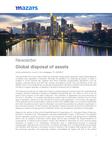
Global disposal of assets
Through Article 32 of Law 1258 of 2008, the corporate reorganization operation called "global disposal of assets" was regulated in Colombia. Although its regulation, for corporate purposes, is made in Chapter V of the referred law, together with other corporate reorganization operations, such as mergers, transformations and spin-offs; fiscally, according to article 319 and following of the Tax Statute, this is not considered as a corporate reorganization operation, therefore its tax treatment will be that of a regular operation of disposal of assets and assignment of liabilities.
The referred commercial rule states that "there is a global disposal of assets when the simplified stock company intends to dispose of assets and liabilities representing fifty -sic- (50%) or more of the net worth of the company on the date of disposal". This institution is applicable only and exclusively to the S.A.S., therefore, if a company belonging to another type of corporation intends to carry out this type of operation, Article 32 of the referred law would not be applicable. In this sense, the approval of the operation by the shareholders' meeting would not be indispensable, nor could the shareholder who feels injured exercise its right of withdrawal, nor would the operation be subject to registration in the commercial registry. On the contrary, the operation would be carried out as a normal operation of disposal of assets (and assignment of liabilities) where only its statutory restrictions would apply.
Based on the opinion of the current Superintendent of Corporations, Dr. Francisco Reyes Villamizar, set forth in his book S.A.S. “Sociedad por Acciones Simplificadas” (Legis. P. 283 and ff.), he indicated that the operation would be carried out as a normal transfer of assets (and assignment of liabilities) where only its statutory restrictions would apply. 283 et seq.) indicated the Superintendence of Corporations, in Official Communication number 220-203295 of December 24, 2015, that the global alienation of assets is an "integration mechanism that is materialized through a corporate reorganization operation by virtue of which a company alienates all or a substantial part of its assets and liabilities and receives in exchange money or shares of the company that acquires them; after the exchange operation, the acquiring company consolidates its equity with that of the selling company, which subsists as an investor with a single asset represented by the shares it receives as payment". In view of the total silence of the norm in this respect, it is not understood from where the Superintendence of Corporations concludes, based on the aforementioned opinion, that the consideration received by the transferring company may be given in shares "of the acquiring company" which would constitute its "only asset" after the exchange operation. In this sense, since there is no mandatory rule in this regard nor a rule prohibiting it, it may be the case that the global transfer of assets is made between the company (transferor) and a natural person (transferee), which could pay these with rights or other assets other than money or shares. Apart from this, the global assignment can also be, only, of liabilities (in case the assets of the assignor are so composed) and in such case, what would legally operate there would be the assumption of a liability, which -by itself- constitutes a sufficient consideration without the need to pay it with other goods and much less with shares of the recipient of the liability.
Apparently, the Superintendence of Corporations confuses the global alienation of assets with other organizational figures, related but different, such as the segregation or improper spin-off (also called "dismemberment") and the contribution in kind. Each of these corporate reorganization mechanisms has a different cause and purpose, and therefore they should not be confused, nor should one be treated as the other. Thus, while the contribution in kind occurs by virtue of the payment made by the contributor to the recipient in order to cancel the value of some shares acquired in the framework of a stock subscription agreement, the segregation or improper spin-off occurs by virtue of the dismemberment that a company makes of a line of business or commercial establishment in favor of one of its subsidiaries, receiving in exchange the latter (and not its shareholders) shares of the recipient.
Finally, due to the way in which the figure of the global transfer of assets was regulated in the corporate law, it is not possible to indicate that such figure must occur between two companies, being the recipient a natural person or a non-corporate entity (non-profit entity, autonomous patrimony, private equity fund, among others) or that in exchange for the transfer of assets or liabilities the transferor must necessarily receive shares of the recipient, which, as mentioned above, would turn this figure into another corporate reorganization operation.


